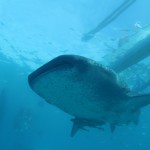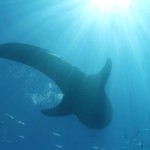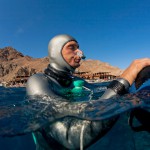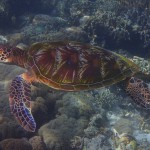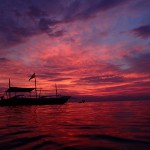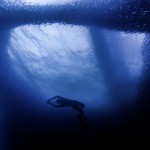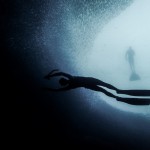Parāoa Freediving
Freediving
is the oldest and most natural form of diving with only a single breath. It has been used for thousands of years to collect shells, pearls, sponges and to catch fish.
Gradually, over several decades, freediving has found a place in competitive sport where longer apnea times, distances and depth performances have been achieved.
Come and experience the feeling of being one with the sea, dive into the realm where life once began. Enjoy the peace and quiet, surrounded by an incredible variety of life.
Freediving improves physical and mental self-awareness and will help you to harmonize this interaction better.
Courses
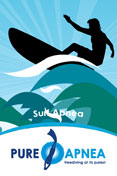
Survival Breath Hold
Survival Breath Hold
SURF APNEA
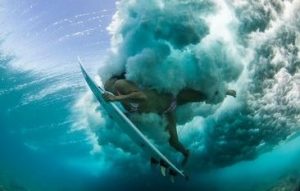 This is a breath-hold course specifically designed for surfers and water users who encounter big wave conditions and are forced to hold their breath spontaneously. The course focuses on breathing and breath-hold techniques, handle hold-down situations which are tailored to surf conditions.
This is a breath-hold course specifically designed for surfers and water users who encounter big wave conditions and are forced to hold their breath spontaneously. The course focuses on breathing and breath-hold techniques, handle hold-down situations which are tailored to surf conditions.
The Surf Apnea course is open to healthy water users over 14 years of age. On successful completion you will have held your breath for over 2 minutes, endured a 3-wave hold down simulation, rescued and revived another person and passed an exam which will qualify you for a Pure Apnea certification.
Surf Apnea is a dedicated 1-day survival breath hold course which consists of :
– Theory sessions
– Breathing techniques
– Dry statics (breath holds on land)
– Wet statics (breath holds submerged)
– Ear equalization
– CO2 static table
– 3-wave hold down simulation
– Rescue and revival
– Apnea walking
– Theory exam
Prerequisites :
18+ years of age or
16+ years with parental consent or
14+ years with parental consent and physician’s signature on the medical questionnaire,
comfortable swimming and snorkelling, signed medical questionnaire and liability release form.
Price : 6000 Peso

Discover Freediving
Discover Freediving
This is a basic entry-Level course which covers the essential techniques needed to freedive safely in a confined water environment.
This course is open to adults (+16 years with parental consent) who are healthy and comfortable in swimming or snorkelling. It covers theory, breathing and breath hold techniques, pool training and safety. After successfully completing the Discover Freediving course, you will be able to hold your breath for over 2 minutes and will be able to participate in Dynamic and Static training and competitions.
This course does not include depth training, but you will be allowed to complete the Level 1 Freediver course in only 1 day instead of 2 or you can continue with the “Adventure Freediver” course.
To complete this course, students will need to fulfill these core requirements:
– Complete a 2 minute Static breath hold
– Perform a confined water rescue
– Dive a distance of 25m in a pool with fins
– Achieve a 70% minimum pass rate for the theory exam
Prerequisites :
18+ years of age or
16+ years with parental consent or
14+ years with parental consent and physician’s signature on the medical questionnaire,
comfortable swimming and snorkelling, signed medical questionnaire and liability release form.
Price : 7000 Philippine Peso including certification fee (+500 Peso for equipment rental)
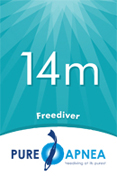
Level 1 Freediver
Level 1 Freediver
This is a 2 day foundation course that covers the basics of freediving.
It includes :
Freediving Physiology, Breathing, Safety, Pressure & Equalization, Freediving Disciplines, Freediving Equipment!
(in detail : breathing mechanism, airways, cardio-vascular system, gas exchange, urge to breathe, hyperventilation, breathing before and after diving, rescue scenario and dealing with blackouts, pressure and equalization, freediving equipment)
This course consists of two theory, one confined water and three open water sessions.
To complete this course, students will need to fulfill these core requirements :
– Freedive to 14m (max. 20m)
– Perform a rescue from 8m
– Complete a 2 minute static breath hold (max. 3 min)
– Achieve a 70% minimum pass rate for the theory exam
Prerequisites :
18+ years of age or
16+ with parental consent or
14+ years with parental consent and physician’s signature on the medical questionnaire,
comfortable swimming and snorkeling, signed medical questionnaire and liability release form.
Price : 13000 Philippine Peso including certification fee and equipment (discount with own equipment)
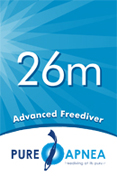
Level 2 Freediver
Level 2 Freediver
This is a 3 day course designed to equip freedivers with the knowledge and skills to become proficient and independent.
Students will learn to become more energy efficient; to prepare their bodies for increased and decreased pressure on land and water; to perform advanced equalization technique; to organize and run training sessions and to do it all safely!
(in detail : lung and body stretching, lung measurements, failure depth, mammalian diving reflex, training for freediving; anaerobic training – CO2 tables, efficiency; duck dive, dolphin and flutter kick + buoyancy and freefall, advanced equalization technique, deep safety and rescue, buddy system, respiratory barotraumas, LMC – BO – AHB, knots)
This course consists of seven theory, two confined water and four open water sessions.
To complete this course, students will need to fulfill these core requirements :
– Freedive 26m deep (max. 30m)
– Perform a rescue from 15m
– Perform a 30m rope rescue
– Complete a 3 minute static breath hold (max. 4 min)
– Achieve a 70% minimum pass rate for the theory exam
Prerequisites: 18 years of age or +16 with parental consent, completed Level 1 or equivalent, signed medical statement and liability release form.
Although not a prerequisite, it is highly recommended that students complete a CPR and First-Aid course before or directly after this course. DAN or equivalent certifications are suitable.
Price : 18000 Philippine Peso including certification fee (+1000 Peso for equipment rental if needed)
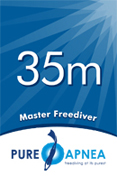
Level 3 Freediver
Level 3 Freediver
The 4 day Master Freediver course is essential for those who want to freedive deep, freedive competitively or who would like to continue progressing towards Instructor Level.
In this course the emphasis is placed on freediving beyond failure depth, equalizing using the Mouthfill technique, stretching and training techniques that will prepare your body for depth and pressure, learning the physics of deep freediving, deep freediving safety and rescue.
(in detail : lung expansion and contraction – packing and reverse packing, FRC diving, full exhale diving, training for depth, Nutritions – suitable and unsuitable food, Decompression Illness – DCS & AGE, Narcosis, Frenzel-Mouthfill EQ)
This course consists of three theory, one confined water and six open water sessions.
To complete this course, students will need to fulfill these core requirements :
– Freedive 35m deep (max. 40m)
– Perform a rescue from 20m
– Perform a 40m rope rescue
– Complete a 3 minutes and 30 seconds static breath hold (max. 5min)
– Achieve a 70% minimum pass rate for the theory exam
Prerequisites: +18 years of age or +16 with parental consent, completed Level 2 or equivalent, signed medical statement and liability release form.
Although not a prerequisite, it is highly recommended that students complete a CPR and First-Aid course before or directly after this course. DAN or equivalent certifications are suitable.
Price : 20000 Philippine Peso including certification fee (+1000 Peso for equipment rental if needed)
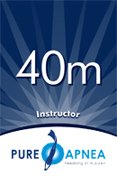
Instructor
Instructor
This course is aimed at Master Freedivers who would like to become freediving professionals and teach others how to freedive.
On successfully completing the course, instructors are certified to teach the Level 1 and Level 2 Freediver courses.
Course duration : minimum of 7 days, depending on your level.
Prerequisites: +18 years of age, completed Level 3, signed medical statement and liability release form, hold an active CPR and oxygen provider certification.
Price : around 38000 Philippine Peso

Master Instructor
Master Instructor
The Master Instructor qualification allows Instructors to teach the Level 3 Master Freediver course.
This is the most challenging qualification amongst all the freediving education systems and organizations as it requires candidates to teach and perform deep freediving skills. This includes a mandatory 60m qualifying freedive (CTW)!
Prerequisites: +18 years of age, completed Instructor course, signed medical statement and liability release form, hold an active CPR and oxygen provider certification.
Price : on request
Training
Training
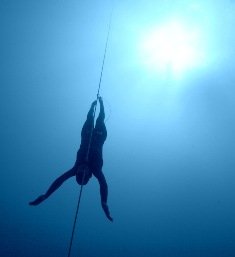 If you have fun with freediving and want fine tune your skills or simply improve your performance, then training is tailored to your wishes and ideas!
If you have fun with freediving and want fine tune your skills or simply improve your performance, then training is tailored to your wishes and ideas!
Only for certified freediver!
Along with it we will :
– provide you with set up and safety
– evaluate your abilities
– improve your technique
– plan and modify your dives
– give you a feedback after each dive
On demand with video documentation!
Price:
2000 Philippine Peso for 1 person/session – discount when booking more than 3 sessions
3500 Philippine Peso for 2 person/session – discount when booking more than 3 sessions
Clinic
Clinic

Problems of any kind can affect your success in freediving. This can be of mental, physical or technical nature. If you have experienced any problems of this kind, then don’t hesitate any longer and let us help you.
To address your problem as best as possible and to see what’s been going wrong in the past, the clinic works on a 1:1 basis to make sure you get the full attention :
- a preliminary talk and depends on the problem we will tailor a schedule
Price : on request
Special Courses
Special Courses
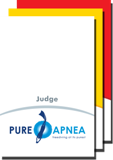 The Pure Apnea Judge course will equip you with the knowledge and skills to perform judging duties at Pure
The Pure Apnea Judge course will equip you with the knowledge and skills to perform judging duties at Pure
Apnea competitive events. The course covers the Pure Apnea rules and regulations, the equipment and preparations
needed to run an event, and judging practice. Candidates must pass a practical and theory exam to become
a certified Judge.Prerequisites: +18 years of age, competition experience or experience organizing competitive
freediving events, hold an active CPR and First Aid certification, signed medical statement and liability
release form. Price : 4500 Philippine Peso
 In this course we focus on diving without fins, the most natural and challenging form of freediving. First,
In this course we focus on diving without fins, the most natural and challenging form of freediving. First,
we will look behind the technique of this modified breaststroke and discuss it.
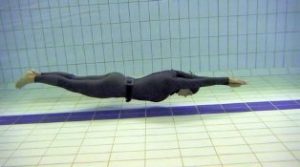 We will practice the movement on land and water, horizontal and vertical, adjusting depends on the discipline
We will practice the movement on land and water, horizontal and vertical, adjusting depends on the discipline
DNF or CNF, weight and speed! Minimum 1 theory session, 1 pool session and 1 deep dive session on rope. Course
duration depends on your level and your personal desire! With video documentation! Price : 4000 Philippine
Peso/day
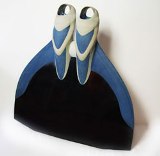 In this course you will learn how to swim and dive efficiently and harmoniously with the monofin.The course contains
In this course you will learn how to swim and dive efficiently and harmoniously with the monofin.The course contains
a stretching session specifically for the monofin, movement training without fin with dolphin kick, movement
training with small fins, one
training session with a monofin in pool, a deep dive session vertical on rope. Course duration depending
on your level and your personal desire. A monofin is not provided! With video documentation! Price : 4000 Philippine
Peso/day
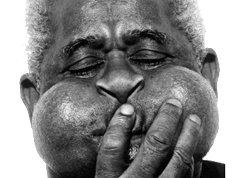 Do you have problems with equalization at greater depth? Then learn this deep equalization technique! For this
Do you have problems with equalization at greater depth? Then learn this deep equalization technique! For this
purpose, we will : Revise relevant anatomy, practice self-awareness training on land, perform dry equalization
exercises on land, dive in open water, vertical on rope. The length of the course depends on your level and desire.
Only for advanced and certified freediver!
Price : 4000 Philippine Peso/day
About
Clemens
Clemens
Since he was a kid, he loved it to snorkel or just to keep his head under water while holding his breath to look at the sea life.
Sport always played an important part in his life. He won countless competitions in athletics and became Berlin Indoor Champion when he was a teenager.
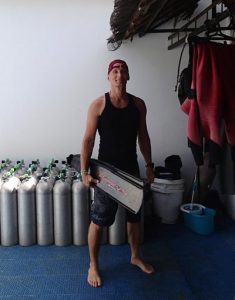 However, his affinity for water still endured. He made many trips to the sea for snorkeling and scuba diving and began freediving in 2006, this sport captivated him straight away. He had the immediate luck from the start to train with successful and experienced freedivers, such as Jens Berger and Wolfram Neugebauer, where he learnt a great deal.
However, his affinity for water still endured. He made many trips to the sea for snorkeling and scuba diving and began freediving in 2006, this sport captivated him straight away. He had the immediate luck from the start to train with successful and experienced freedivers, such as Jens Berger and Wolfram Neugebauer, where he learnt a great deal.
Since 2007 he worked as a safety diver and coach in many national and international competitions.
In 2010 he became an AIDA instructor and since 2013 he is instructor trainer for Pure Apnea where he is running courses of all levels.
He is an international competition Judge for Pure Apnea and AIDA.
My philosophy :
I am not a freediving factory and not interested to certify as much as possible. I hold things on a small scope and go in this point a different way than my colleagues. This is the only way I can ensure that I never lose the pleasure in what once started as a hobby. The classes take place only with a maximum of two people at the same time to ensure you get my full attention!
Success in deep diving :
- 2012 – 15th best performance in competition world ranking with 58m without fins
- 2012 – 12th best performance in competition world ranking in all 3 depth disciplines together
Parāoa
Parāoa
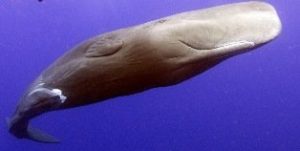 Parāoa means in Maori language Spermwhale. (Maori = indigenes people of New Zealand)
Parāoa means in Maori language Spermwhale. (Maori = indigenes people of New Zealand)
To the indigenous Maori of New Zealand, the Parāoa or spermwhale has a deep cultural connection and is seen as a holy animal.
My reverence for this mammal has been inspired by their performance in the search for their favorite food – the giant squid, who lives in the darkest and coldest realms of deep ocean. The Parāoa is the true champion of freediving with extraordinary two thousand meter deep dives and one and a half hour long breath holds – really trivialising human capabilities!
Here some data and facts about this mammal :
- scientific name : physeter macrocephalus
- females grow up to 15 meters, weighing 25 tons and males grow up to 25 meters coming in at 45 tons
- deepest recorded dive : 2250 meters in one hour and 13 minutes
- biggest brain on earth (up to 9 kg)
- longest intestines on earth (200 meter)
- heart size up to 1 m³
- males live up to 70 years and up to 100 years for whale cows
- current population approximately 360 000
- has the strongest sonar system in the animal kingdom and has the loudest sound produced by any animal on earth
For interested people, the physiology of the spermwhale more in detail :
The head of the whale contains a liquid wax called spermaceti from which he got his name (in German language the whale got his name because of his pot shaped head, Pottwal). This head makes approximately 1/4 of his body size and 1/3 of his body weight. Spermaceti oil was originally mistaken by the people in the middle age as the whale’s semen, because the wax part of the oil in contact with cold water crystallizes and turns white in color. People used to believe, that the head was used for reproduction and that was finally the reason for its name, which endures to this day.
Spermaceti was used mainly for the production of high-quality, brightly burning and non-smoky candles, such candles were known to be the best quality. As one “Candela” was originally defined in England the intensity of a spermaceti candle, which consumed 7.77 gram spermaceti in an hour. Even as a lubricant for precision instruments, and to engines and automatic transmission oils, it was highly appreciated. In addition, it was also used as a raw material for cosmetics and pharmaceuticals.
Each whale’s head has their own asymmetry of his head. The blowholes are not in the crest center, they are on the left front of the outer edge of the head. The paired nose opening is connected with two nose gears, the left one is crossing through the whole spermaceti organ almost straight, the right nose gear on the other hand is expanded to a curvy and shallow channel. Just for breathing this construction looks too complicated. Consequently, this gave speculations for another function.
Spermwhales are able to waylay motionless on the sea floor, waiting for approaching squid, but dead spermwhales floating on the surface. Consequently they have to make themselves heavier while descending. This complicated function is taking over the spermaceti organ, which extends over the whole head.
The function is the following :
The left nose gear will flooded with seawater, for diving it is expendable. A ring muscle (musculus maxillonasalis) is closing the entrance of trachea and lung. The whale is using the same principles for the right and curvy nose gear like a submarine, which is flooding his tanks, in this case its spermaceti organ with water for descending, and pressing the water out for ascending.
The only difference to the submarine is that the whale is cooling down at the same time as the spermaceti. In this process the wax content of the sperm oil crystallizes out. The weight proportion of wax is about one third of the sperm oil and is above 21 degree Celsius liquid and below 18 degree Celsius crystalline solid.
This difference means that the cooled down and crystallized spermaceti organ takes 2.2% less volume than the liquid one. In the solid state, and this is important, it gets a higher density. This means the whale can so alter its specific weight in order to reach great depth or to resurface with very little exertion. The whole process of crystallization is accelerated by the shutdown of the blood circulation.
On the assumed size of a sperm whale cow of 25 tons, of which is about 2.5 tons of spermaceti. After the exhalation, the animal is in the hover (plus minus zero). After the transition of the spermaceti to the crystalline form and the associated change in specific gravity of the spermaceti organ, the conditions are not present any longer. The increase in head weight makes the whale negatively buoyant, causing an initial descent rate from 1.5 to 2.2 meter per second which can be directly observed during the plunge when the animal raises the fluke in the air and then starts diving vertically. The descent occurs nearly without active swimming movement and consequently with very little oxygen consumption.
The deeper the whale dives, the more solid and dense the spermaceti becomes, because it is getting colder in greater depth and the pressure is increasing. The whale becomes more and more heavy and is able to descend faster. If the whale wants to ascend, they just empty their right nose gear and links up the blood circulation. This warmes up the spermaceti cushion; the process reverses and the animal returns with very little effort back to the surface.
After 60-70 breaths (10-15 min), they are able to dive again. Spermwhales are able to exchange 80-90% of their lung volume in one breath, not like humans with 10-15%! As a result of this he can re-oxygenate his body very quickly. Spermwhales always dive exhaled, so they avoid the Caissonsche disease. In relation to their body the lungs are very small. In order to meet the oxygen requirement for immersion times of over an hour, the whales developed special adaptation methods.
The whale has a higher content of hemoglobin between 39%-45%, compare to land mammals which is between 30-34%, so they can uptake a greater amount of oxygen faster. The amount of blood in relation to the body weight is quite small. The whale has a blood volume of 3,9% of his body weight, a land mammal has 10-13%. However we must not forget, that the whale fat layer makes up a large part of the weight. Whale blubber and spermaceti can absorb oxygen up to seven times more than water, so it is a very good oxygen facility. More detailed facts about this mechanism are unknown at the moment.
The most significant oxygen storage represents the myoglobin. Similar to hemoglobin in the blood, myoglobin is a muscle protein which binds oxygen. The whale has 8 to 9 times as much myoglobin in the muscle than found in a land mammal. Whale meat is dark red, nearly black, which is due to the extremely high density of myoglobin in the muscles. Actually, this high amount of the protein would orinarily clump together and therefore be dysfunctional, but obviously after 50 million years evolving within the whale, that is just not the case. The reason is found in the protein itself. For all record divers the electrical charge on the surface of the protein is higher than that of their non-diving relatives. The electrically charged surface makes the myoglobin molecules keep distance from each other, even if they occur in unusual concentration.
The whale incorporates 40% more oxygen than humans. For Spermwhales it’s not like humans where a high level of CO2 gives the stimulus to breath, but the oxygen deficit.
When the whale starts diving, all organs that are not needed, can be disconnected by the presence of constricting sphincter muscles in the venous blood vessels.
Like some other mammals, the heart rate drops drastically at the beginning of the dive.
During the dive, only brain, heart, spinal cord and a part of the muscles are supplied with oxygen. The rete mirable, a sponge-like complex of arteries and veins very close to each other, take up a great amount of blood acting as an oxygen store.
A further ability of the whale to go easy with oxygen is that the muscles are temporarily deprived during the dive, however this is only in extreme situations. By anaerobiosis glycogen instead of oxygen is used to fuel the muscles. This causes lactic acid, which remains in the muscles until after re-surfacing, unlike in humans where it is released straight into the bloodstream.
The spermaceti organ has another important function. It acts as a focusing apparatus for the whales sense of echo-location and a resonator. This makes it possible for the whale to sense the motion of its prey better as well as its position. The changing distance to the prey affects the time interval between the returning clicks reflected by the prey (doppler effect). This explains the high density and compressibility of the spermaceti, which enhance the resonance by the contrast of the acoustic properties of the sea water and of the hard tissue surrounding the spermaceti.
Freediving Disciplines
Freediving Disciplines
- In static apnea (STA) the freediver holds his breath for as long as possible with the airways submerged.
- In dynamic with fins (DYN) the freediver dives in a horizontal position below the surface, attempting to cover the greatest possible distance.
- In dynamic without fins (DNF) the freediver dives in a horizontal position below the surface (usually in breaststroke), attempting to cover the greatest possible distance. Propulsion devices are prohibited.
- In constant weight with fins (CWT) the freediver attempting to go as deep as possible and to reach the target depth. Only during the turn it is allowed to touch/pull the guiding rope.
- In constant weight without fins (CNF) the freediver attempting to go as deep as possible and to reach the target depth (usually in breaststroke). Only during the turn it is allowed to touch/pull the guiding rope. Propulsion devices are prohibited.
- Free immersion (FIM) is another deep diving discipline. Also here, the freediver attempting to go as deep as possible and to reach the target depth. In this discipline the athlete descents and ascents by pulling himself along the rope, without using of any propulsion devices.
- In variable weight (VWT) the freediver descends with the help of a ballast weighted sled. It remains in the end depth. For the ascent the athlete is pulling himself along the rope and/or using fins.
- As the name suggests, in No Limits (NLT) are no limitations. The athlete descends with the help of a ballast weighted sled and ascends with a system of his/her choice.
Avoid 1
Avoid 1
Tips for a healthier lifestyle
Prolog :
We are living in an era of fraud, not just in banking, government, education, religion, information and healthcare, but in food!!!
Nutrition is closely linked to our highest good, our health. Unfortunately, for the most diverse reasons, we do not question enough about the practices of the commercial food industry. Neither the physical nor the mental health of the people is in the foreground for them. Profit also seems to play a major role here.
So we overflow our body daily with destructive food and food additives which must have consequences after countless years of mistreatment. So-called “lifestyle diseases” such as cancer, cardiovascular diseases, arthrosis, chronic illnesses and diabetes, to name just a few, are the results. Conveniently, our “healthcare” system is designed to cure primarily symptoms, not its real causes, supporting so this fraudulent system.
Commercial produced fruits and vegetables are grown in abused, bastardized, mineral-poor, depleted soil which is saturated with poisonous synthetic chemical fertilizers. The chemical poisons from the fertilizers are absorbed into the plants we eat.
Those products, which look all so pretty in the supermarket, are furthermore heavily sprayed with pesticides, herbicides and other killers which not only kill bugs and weeds, but kill you also – little by little with each mouthful.
In fact, likely everyone on earth, including our animals, have toxic pesticide residues in the body that contaminate and irritate our cells. Washing, it may remove a little, is generally ineffective.
This is the food we are eating today!!!
The commercial food industry is not a friend and they are not looking out for our best interest. They attack us with healthy-sounding buzzwords and phrases, but, for the most part, are trying to catch our attention to sell us cheap, destructive, non-nutritious junk.
No matter how many labels and fancy words you find on a package, always read the label and know what ingredients are what. Know the whole story.
The facts :
400,000,000 tons of chemicals are produced each year!
140,000 tons of pesticides are sprayed annually in Europe!
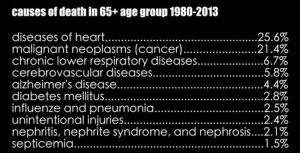
If our corrupted governments don’t stop the increased application of genetically modified organisms (GMO’s), I predict, that cancer and other related diseases will grow exponentially!
The only animals that are really getting sick in the animal kingdom are us, and the animals we feed. Doesn’t that tell you something?
Main part :
I am aware that I can not list all things that you have to banish from your life, but with this article, a first good start should be made to reduce those pollutant food.
The speech is in part 1 about :
5. hormones in plastic and environment
In part two I will talk about:
Pesticides, flavor enhancers, colorings, preservatives, antioxidants, emulsifiers, stabilizers, acidifiers, gelling -and- thickeners, coating agents, and genetically modified food!
Avoid 2
Avoid 2
in progress
Location
- Location
- Moalboal belongs to the Central Visayas, a group of islands in the centre of the Philippines archipelago. It is part of the province Cebu, located in the southwest of the island, about 90 km away from Cebu City!
- How to get there
- After arriving in Cebu City, take a bus in southern direction (from south bus terminal) with Ceres buses or others and get off in Moalboal City. From there, use a tricycle or motorcycle and go to the Kasai Village Dive Resort. (tricycle 70-100 Peso, motorcycle around 40 Peso, depends how good you can bargain). The cheapest places to stay are in Panagsama, around 2 km away from Kasai!
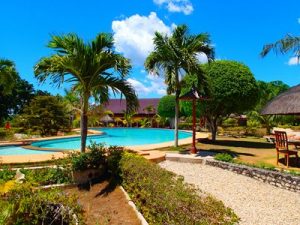
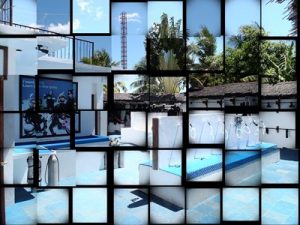
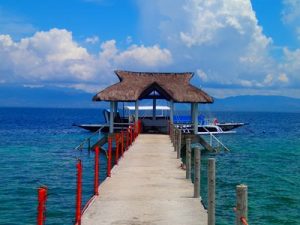
Blog
Busy world we’re living in is keeping many of us in the loop of negative stress, mental discomfort and general health abandon. With things we like we can channel ourselves on the right path and gain life quality by changing our routine with something nice, fun, rewarding and challenging.
Freediving is living the life in the present moment without surrounding interferences. It is a value which is giving us so much but it’s nearly impossible to paint it with words. Maybe we can share the same feelings Alpine climbers in the mountains, astronauts who make their child dreams happen, artists absorbed into their work where every gesture, word, voice, sound or movement is crucial.
Freediving is obviously reflecting on our everyday life in the way to tune the mind and the body into one whole well balanced structure which can with regular activity makes us physically super fit and mentally stronger. During all of our courses we’re correcting your breathing routines with more correct patterns which can benefit our life quality or at least boost life energy and relaxation. Gaining the power of breath and other Freediving features will not just help you to stay longer underwater but will help you to dive deep into yourself and hopefully find the rewarding part of this beautifully activity.
read more postsContact
Links

- Kasai Village
Dive & Spa Resort! 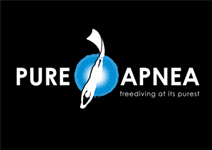
- Pure Apnea
Freediving at its purest! 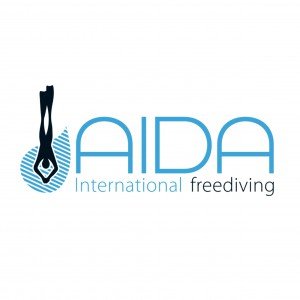
- Aida International
AIDA International is the Worldwide Federation for breath-hold diving! 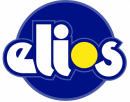
- Elios
Leader in wetsuits and diving accessories. Tailor made wetsuits!
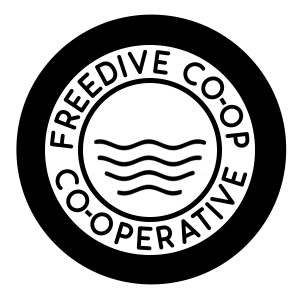
- Freedive CO-OP
An Open Price Project, Tailored Courses-Coaching-Training! 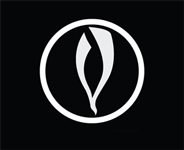
- Freedive Panglao
Freediving in the Philippines! 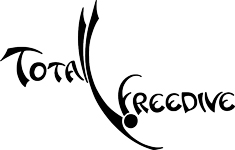
- Total Freedive
Total Freedive is a freediving school currently based in Dahab, Egypt!




